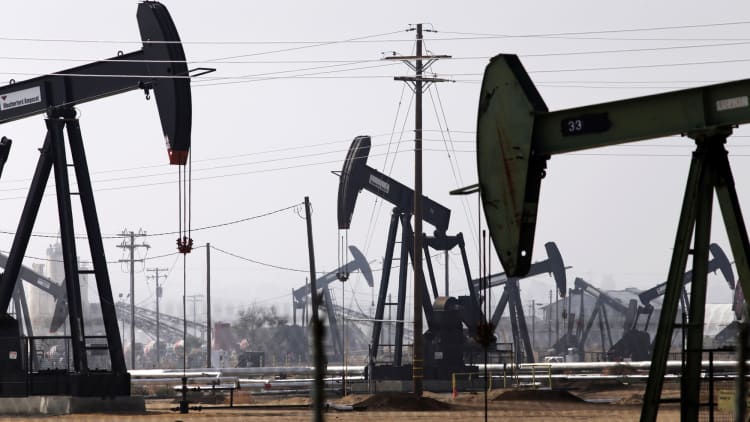
Oil prices extended losses on Tuesday after an industry group reported a far larger rise in weekly U.S. crude stockpiles than anticipated.
U.S. crude oil in storage rose by 14.2 million barrels last week, according to the American Petroleum Institute. That was more than five times analysts' forecasts for a 2.5-million barrel increase.
Gasoline stocks rose by 2.9 million barrels, compared with analysts' expectations in a Reuters poll for a 1.1-million barrel gain.
U.S. crude was trading at $51.72 after ending Tuesday's trade down 84 cents, or 1.6 percent, at $52.17.
Benchmark Brent crude was down $1.03, or 1.9 percent, to $54.69 a barrel by 4:50 p.m. (2150 GMT).
Concerns that U.S. gasoline consumption is stalling weighed on futures. U.S. gasoline prices fell 2.3 percent.

Futures were pressured on Tuesday by sluggish demand and evidence of a burgeoning revival in U.S. shale production that could complicate efforts by OPEC and other producers to reduce a supply glut.
Gasoline stockpiles rose by almost 21 million barrels in the first 27 days of 2017, compared with an average increase of less than 12 million barrels at the same time of year during the previous decade, according to official inventory data.
"It's a supply-driven setback ... We are within 2 million barrels of the record in U.S. gasoline stocks that we saw last February," said Tony Headrick, energy markets analyst at CHS Hedging. "A strong build in inventory reports could weigh on gasoline in a seasonal timeframe where gasoline demand is weak."
Inventory estimates from trade group the American Petroleum Institute are due on Tuesday afternoon. U.S. government data is reported Wednesday.
Gasoline futures fell below the 200 day moving average on a continuous chart, Headrick noted.
The U.S. dollar rose 0.4 percent against a basket of currencies, making dollar-denominated commodities like crude oil more expensive to holders of other currencies.
Prices have been supported for two months as the Organization of the Petroleum Exporting Countries and other exporters have tried to cut output by almost 1.8 million barrels per day (bpd) in the first half of 2017. OPEC and Russia have together cut at least 1.1 million bpd so far.
Another bullish sign emerged on Tuesday as crude oil exports from southern Iraq fell in January to 3.275 million barrels per day (bpd) from 3.51 million bpd in December, according to two oil executives.
Iraq, OPEC's second largest producer, has been a concern among analysts because it has a harder time managing output than some other cartel members. Its leaders also raised issues with the coordinated production cuts from their inception.

But market players are concerned that rising U.S. production and signs of slowing demand growth could offset these efforts.
"The general perception is that OPEC is cutting production, which is supporting prices, but high stock levels, rising rig counts and growing U.S. production are capping gains," said Tamas Varga, analyst at London brokerage PVM Oil Associates.
Societe Generale oil analyst Michael Wittner said U.S. shale oil output was recovering faster than expected.
"Rig counts are increasing at an accelerating pace, and given the technological advances of the past three years, this should translate into significant supply," Wittner said.
"U.S. shale is coming back, and it's coming back strong."
U.S. oil production is expected to rise 100,000 barrels per day to 8.98 million barrels in 2017, 0.3 percent less than previously forecast, according to a monthly U.S. government report released on Tuesday.
Chinese oil demand grew in 2016 at the slowest pace in at least three years, Reuters calculations showed, the latest sign of slower demand from the world's largest energy consumer.
Correction: This story has been corrected to reflect the total stockpile build reported by API was 14.2 million barrels.
— CNBC's Tom DiChristopher contributed to this report.

